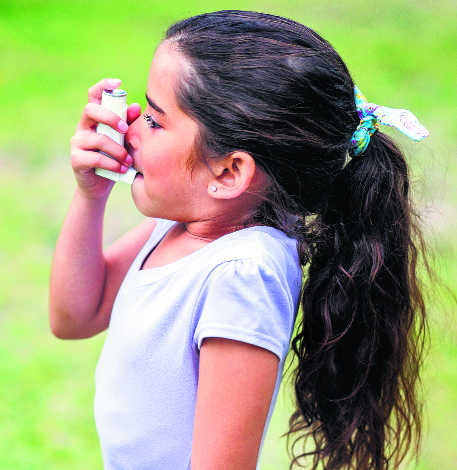
Dr Mahesh Hiranandani
About 30 million Indian children suffer from asthma. It restricts their daily routine activities affecting even normal playing time. This forced sedentary lifestyle affects their metabolism often resulting in their gaining weight and eventually becoming obese.
It appears that asthma plays a major role in shaping their lives for worse. While it can’t be cured, asthma can be controlled well. Children whose asthma is well controlled can lead happy, healthy lives. Poorly controlled asthma can have a big impact on a child’s health, leading to school absenteeism and negatively affecting their ability to learn and play.
Early signs
Frequent coughing and wheezing before the age of six are signs that a child may have asthma. The main site of trouble in asthma is the terminal air passage which narrows in response to a number of environmental factors like dust, smoke, viral infections, pollens, fumes, dangerous chemicals and food additives. If these episodes of coughing/wheezing become frequent and last for many weeks to months, a clinical diagnosis of asthma should be considered. Unfortunately, there is no single confirmatory test to label a child as asthmatic hence the poor acceptance of the diagnosis. WHO estimates that about 10-15 per cent children in India are suffering from asthma and this is a huge burden on the parents which needs to be shared by doctors, policy makers, researchers and politicians.
Relax, it’s just asthma
Most parents initially reject the diagnosis of asthma in their child because of denial and a feeling of guilt on not being able to do enough to prevent it. Parents report uncertainty of symptoms and their inability to appropriately handle a severe attack as one of the greatest stressors of having a child with asthma. It’s perfectly normal for parents to worry about this problem. But asthma can be managed with medication and other measures. The sooner the parents consult an expert, the better it is for them to understand its management.
For effective management
As a parent or the guardian of a child who has asthma, there are several things one can do to make it easier for them to cope with the disease. The goal is to relieve the symptoms and to help the child lead a fairly normal life. Parents must help children to take the medications appropriately. It’s also important to try to make sure that the child feels “normal” amongst friends, family, neighbours and at school. Many teens don’t know how to deal with the diagnosis at first. They may feel embarrassed and try to keep it a secret. Many children also tend to constantly worry about asthma attacks. Supportive parents are a great help. Smoke-free environment can prevent kids from an acute attack of asthma. Second-hand cigarette smoke damages your child’s lungs and makes asthma symptoms worse.
Breathe easy with inhaler
Asthma patients no longer need to be hospitalised frequently. Inhaler therapy has revolutionised the asthma management to such an extent that most attacks can be managed successfully at home by parents. An inhaler is the most effective method of giving asthma medication as it ensures that the medication goes directly to the lungs where it is needed and the patient also receives smaller dosages than oral medicines.
There are two types of inhalers. One that helps you when you are having trouble breathing is called a “reliever” medication (blue inhalers). The quick-relief medicines help when you
are having asthma symptoms. These work quickly to help you breathe easier. This type of medicine is also used before exercise.
A second type of inhaler is for every-day use to control asthma. This is called a “controller” or “maintenance” medication (brown inhalers). These are steroids in low doses and are the mainstay of therapy to be taken for weeks or months for preventing further attacks. These decrease the swelling and puffiness in the lungs. It is important to take these medications every day – even if you are well. Remember, asthma attacks can be more dangerous than the minor side effects of “controller” medications. Steroids are perfectly safe when taken under supervision. Parents must resist the temptation of using “unscientific”, “alternative” or “natural” therapies which guarantee permanent cure but have no scientific basis and have been proven to be harmful.
Asthma is a chronic condition of lungs with a waxing and waning course in early years of life. But not everyone who has asthma as a child will also have it as an adult. Sometimes the symptoms disappear completely after puberty. But even when this happens, the airways may usually remain sensitive and certain triggers can still make them become narrower causing asthma symptoms.
However, the good news is that asthma doesn’t necessarily keep getting worse – especially if you get the right treatment at the right time for right duration.
Contrary to earlier genetic hypothesis of asthma, most children who are now detected have no family history. This gives credence to human race being responsible for creating polluted cities and making their own children victims of this ecological disaster. However, new-age therapies have made this disease an easily treatable problem.
Common childhood symptoms
- Frequent, intermittent coughing
- A whistling or wheezing sound when exhaling
- Shortness of breath
- Chest congestion or tightness
- Chest pain, particularly in younger children
- Trouble sleeping caused by shortness of breath, coughing or wheezing
- Bouts of coughing or wheezing that get worse with a respiratory infection, such as a cold or flu
- Repeated episodes of suspected bronchitis or pneumonia
- Delayed recovery or bronchitis after a respiratory infection
- Trouble breathing that may limit play time
- Fatigue caused by poor sleep
When to seek emergency treatment
In case of a severe attack, an affected child’s chest and sides may pull inward as he/she struggles to breathe. The child may have increased heartbeat, sweating and chest pain. Rush to doctor/nearest hospital if a child:
- Is stopping mid-sentence to catch breath;
- Uses abdominal muscles to breathe;
- Has widened nostrils while breathing in;
- Is trying so hard to breathe that the abdomen is sucked under the ribs when he/she breathes in.
—The writer is head, paediatrics, Cloudnine Group of Hospitals, Chandigarh



























